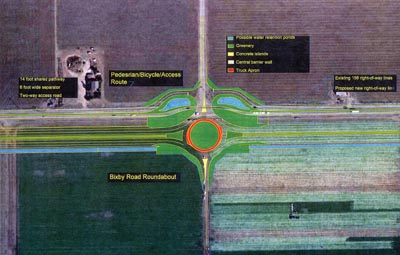Representatives from San Benito County are preparing to present
new alternatives for the Highway 156 project to the California
Department of Transportation in the upcoming weeks.
Representatives from San Benito County are preparing to present new alternatives for the Highway 156 project to the California Department of Transportation in the upcoming weeks.
The new alternatives, which were created during a two-day workshop with more than 15 community members, introduce three roundabouts and a bike trail to the project. The workshop, sponsored by San Juan Oaks Golf Club and Save the San Juan Valley group, included a walking tour of the current two-lane highway that connects Hollister and San Juan Bautista.
The widening project, which has been planned for several years, has seen a negative reaction from many San Juan Bautista residents including Supervisor Anthony Botelho. Caltrans proposal would widen the road by four lanes and cut through surrounding farmland. Botelho has openly worried during board meetings about the cost and design of the project.
But Botelho praised the new design proposal.
It would turn a bad project into an “asset,” he said.
The new design includes less farmland, and transforms a planned frontage road into an access road and bike path connecting Hollister and San Juan Bautista. Roundabouts would also replace traffic signal intersections at Union Road and The Alameda, and slow down traffic at Bixby Road. The Bixby Road roundabout also connects the highway with the access road.
The three two-lane roundabouts are projected to better control the roadway and provide “greater safety, and fully accommodating all vehicle types,” according to engineering notes released by the county. Retention pounds are also designed around the roundabouts to “minimize the further taking of precious farmland.”
Notes from the alternatives were presented to the board of supervisors during last week’s meeting at the request of Supervisor Jaime De La Cruz, who wanted to see details before approving a county presentation to Caltrans.
Botelho and Supervisor Jerry Muezner attended the workshop and presented some details to the board a month earlier.
Botelho hoped Caltrans would listen to and use some of the ideas in its expressway project, he said.
“During this workshop, there were concerns … 156 could be a real asset to the county and the region. What came out of that, was some suggestions that hopefully in a week or two, myself and a group of folks can present this to Caltrans,” he said. “Hopefully they have a fair consideration of these ideas. What we have is a project … some alternatives that would turn the 156 expansions or expressway project into a real asset.”
Another workshop attendee, Scott Fuller with San Juan Oaks Golf Club, said the meeting was purely conceptual but did include participation from the roadway’s Caltrans project manager, Richard Rosales.
But despite his participation, Caltrans already announced it didn’t mean they would include the workshop designs into the final project, Fuller said.
“Caltrans participated with the express statement that it was not incumbent on them to necessarily accept the group’s outcome as a whole or in part,” Fuller said. “Everyone that participated knew that from the beginning.”
Rosales said the meeting was informative and some of the design changes, such as the roundabouts, were only minor and it wasn’t too late in the environmental process to include them.
The board agreed in a 5-0 vote to present the workshop’s findings to Caltrans District 5 Director Rich Krumholz in an upcoming meeting that had not been scheduled.
Fuller was confident in the new alternative design and ideas.
“We think, overall, that the conceptual design accomplishes Caltrans goal of safety and the movement of local and regional traffic, while it preserves more farmland and significantly reduces the footprint of the road,” he said. “It slows traffic at key intersections and allows them to go through those intersections.”
He continued: “And if its done right, it could be a gateway to the community that says to the visitor, they are entering an area that respects our history and has a wealth of outdoor recreational opportunities, and is a wine and agricultural region to explore and appreciate. I think it will say what we want it to say as you come into the community.”










